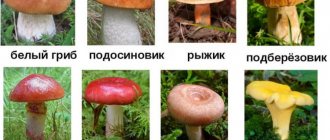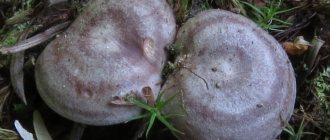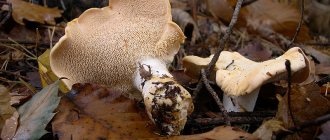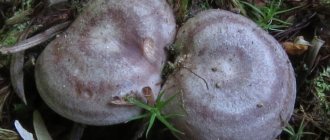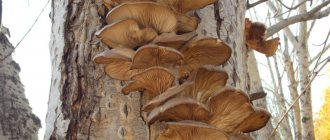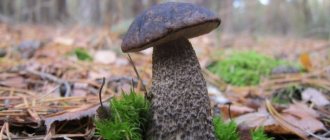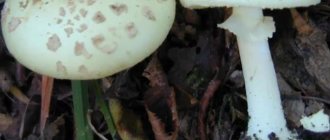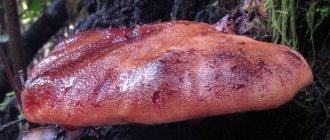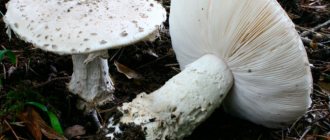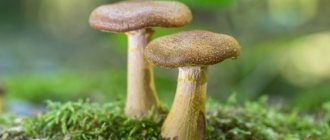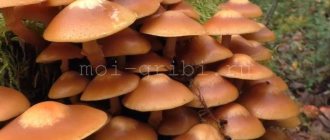In the world of mushroom picking, sometimes events also happen, if not sensational, then surprising - for sure. These include the appearance of the hero of this article, the golden boletus, in Europe and in our country in particular.
Why? Yes, because this mushroom is considered to be a resident exclusively of the American continent and, until recently, was found only overseas. And now news about the discovery of this overseas guest is coming either from the Kaliningrad region (where the golden boletus is no longer a curiosity, but a full-fledged commercial mushroom, collected by local residents not in collectible quantities at all), then from Lithuania, then from the Leningrad region!
How the spores or mycelium of this handsome creature ended up on the European continent is still a mystery. There is, for example, a version that the hyphae arrived from Canada along with spruce seedlings. Be that as it may, this mushroom is already available in Russia, which means it’s worth getting to know it in more detail.
Types of these mushrooms, appearance
The golden boletus (boletus projectellus) has a convex cap that reaches 12 cm in diameter. Its surface has a pink-brown color and a smooth or velvety texture. The porous hymenophore is often depressed around the stalk and becomes yellow or olive-yellow in color. The tubes reach from 1 to 2.5 cm in depth.
The pulp of the golden boletus has a pinkish tint and a dense structure. It practically does not change its color in the section. The legs of this type of mushroom reach a height of 24 cm, taper towards the top and are soft and elastic.
First aid for poisoning
Regardless of the severity of the poisoning, at the first symptoms they seek qualified help at the nearest medical facility or call an ambulance. At home, help the victim to prevent the spread of toxins as follows:
- Rinse the stomach with a weak solution of manganese. The water should be boiled warm, light pink, with a volume of at least 1.5 liters. Divide the solution into five parts and give it to drink at intervals of 11-15 minutes. After each dose, induce vomiting by pressing on the root of the tongue.
- Take adsorbent drugs that absorb and neutralize toxic compounds: enterosgel, polysorb, white or activated carbon.
- In the absence of diarrhea, it is caused artificially by irritating laxatives: guttalax or bisacodyl. If there are no drugs, do a colon cleansing enema with warm boiled water with low concentration of manganese.
If there is no high temperature, a heating pad is placed on the legs and stomach. Give a hot chamomile decoction or unsweetened tea to drink. In case of a sharp decrease in blood pressure, it is normalized with caffeine - this can be a strong cup of coffee or a citramone tablet.
Where, when and how does it grow
Golden boletus grows in small groups. In European countries it is quite rare. The main place of growth is Canada, Mexico, USA and Taiwan. According to the latest data, this type of mushroom can also be found in the Far East, as well as in the Leningrad region.
Boletus can be collected from summer to autumn inclusive, choosing coniferous or mixed forests.
Places of growth
The places where boletus grows are located in the temperate zone of the Northern Hemisphere. The largest harvests of these mushrooms are harvested in the forest zone and taiga; boletus grows less frequently in the forest-steppe. This representative of the Bolet genus does not grow in the tundra, forest-tundra and steppes. Boletuses are also found in the forests of mountainous areas. The closer to the alpine meadows, the less often this mushroom is found. It does not grow at an altitude of 1500-2000 m above sea level.
The name itself says that boletus mushrooms are found in the forest. They love coniferous forests, growing near pines and spruces. They are found next to oaks, chestnuts, beeches and hornbeams. Boletus appears less frequently in birch-coniferous and deciduous forests.
The mycelium envelops the roots of trees, but the fungus is not a parasite; it forms a symbiosis - a micrisis. Without it, the Bolet will not grow, because nutrients enter the tree through the mycelium, and organic products go back to the mushroom. The mushroom also requires a certain type of soil, which is formed only in the forest. This makes it difficult to grow the species at home or on an industrial scale.
Boletus mushrooms begin to be collected as early as June, but the peak season is in August and September. If autumn is cold, mushrooms quickly disappear. In the southern regions, the first forest boletuses appear in May and grow until the end of October. Fruiting bodies grow in humid and warm weather and live no more than a week.
When searching, you should carefully examine the litter under pines, fir trees, hornbeams, oaks and beeches, and places near anthills. Young specimens are small and hide under the leaves. Boletuses rarely grow alone; if you draw a circle with a diameter of 10-15 m around the found specimen, then within its boundaries you will find a whole family.
Application
Due to its high nutritional value, golden boletus is often used in cooking and medicine. So, dishes made from this mushroom can not only diversify your usual daily diet, but also help enrich the body with useful microelements and vitamins.
In cooking
The pulp of the golden boletus has a fairly dense structure; it does not crumble or fall apart, which allows you to preserve the beautiful appearance of dishes. This mushroom also has a pleasant aroma and taste, so it often becomes the basis for various sauces and snacks. Boletus is also excellent for canning or drying.
In medicine
As for medicine, rose golden boletus is used as a natural drug for the treatment of cardiovascular diseases. Regular consumption of this mushroom improves the condition of the skin, nails and hair. Also, alcohol tincture can relieve insomnia, stress and nervous disorders.
Beneficial features
Boletus has an extensive chemical composition, which includes:
- Various vitamins. Most of all, mushroom pulp contains vitamins C, PP, E, D and several from group B.
- Polysaccharides.
- Lots of minerals. Boletus is rich in iron and manganese, and is characterized by the presence of calcium, sodium and magnesium compounds, fluorine and chromium. Traces of zinc and cobalt can also be found in the composition.
- A small amount of chitin (in cell walls). In moderate doses, this substance has a beneficial effect on the body.
- Sulfur.
- Fiber and water.
Chitin is a natural polysaccharide, a characteristic component of the exoskeleton of arthropods and, oddly enough, fungi. It is a type of plant fiber. It is not absorbed in the human digestive tract and makes these processes difficult for mushroom proteins, because forms a natural complex with them. At the same time, chitin is able to actively absorb heavy metals and toxins and remove them from the body during digestion.
When eating boletus, the following effects on humans are noted:
- The functioning of the thyroid gland is normalized.
- The content of harmful cholesterol in the blood decreases.
- The manifestations of atherosclerosis are mitigated and the likelihood of this disease occurring is reduced.
- The body's resistance to cancer is strengthened.
- Cellular structures are renewed, which is facilitated by the presence of the amino acid ergothioneine.
- General immunity increases.
- Resistance to angina pectoris improves and the effectiveness of medications aimed at combating it increases.
- The activity of the gastrointestinal tract is normalized, stool becomes regular, and lazy bowel syndrome disappears.
- Digestion is enhanced due to the additional production of gastric juice.
Boletus has no special contraindications for consumption. However, like all mushrooms, it has the ability to accumulate harmful substances from the environment in its pulp. Therefore, it is worth eating only those specimens that were collected in ecologically clean areas.
Harm and contraindications
Despite the beneficial properties of golden boletus, a number of contraindications to its use should also be taken into account. These include:
- pregnancy;
- period of lactation and breastfeeding;
- children under 12 years of age;
- elderly age;
- active phase of gastrointestinal diseases;
- tendency to allergies;
- individual intolerance to the components of the fungus.
Use
The edible golden boletus has not only a pleasant taste, but also a very rich chemical composition. Its pulp contains useful vitamins - A, C, B1 and D, as well as iron, potassium, calcium and a large amount of protein. Eating the mushroom is useful for improving the functioning of the metabolic system, for strengthening joints and ligaments, for treating anemia and lack of body weight.
Although the golden boletus does not contain toxic substances, it cannot be eaten raw; the pulp must be thermally treated before use:
- The collected mushrooms are cleaned of soil and forest debris, washed in cold water, and then boiled twice.
- First, boil the boletus mushrooms for 5 minutes in unsalted water and drain the broth, and rinse the mushrooms again with cold water.
- After this, the boletus mushrooms are again filled with water and boiled in salted water for 20 minutes; the rising foam must be skimmed off.
After boiling, the golden boletus needs to be rinsed again. Boiled pulp can be used in salads or added to soups; golden boletus is also suitable for frying, salting and pickling. The mushroom is versatile, it has a pleasant taste and provides health benefits in any dish.
Attention! Despite the numerous beneficial properties of golden boletus, it is not recommended for chronic ailments of the stomach, intestines and liver.
Pregnant women and children under 7 years of age should also avoid the mushroom; the body with hypersensitivity may perceive the mushroom pulp negatively.
How to distinguish edible from inedible
The edible golden boletus differs from other species in many ways. However, inexperienced mushroom pickers can easily confuse it with some poisonous specimen. The main ones include:
- Gall mushroom. This is the most common false double of the golden boletus. It looks almost the same, but has clearly visible veins on the stem. In addition, the flesh of this mushroom darkens very quickly when cut and has a pronounced bitter taste.
- Satanic mushroom. This inedible specimen, whose shape is very similar to that of the golden boletus, is common in Europe and the Caucasus. It has a very thick stem, and the size of the cap often reaches 30 cm in diameter. However, unlike the edible species, the Satanic mushroom has a net-like pattern on the stem. And if you cut its flesh, it will very quickly turn blue.
- The boletus is wonderful. This type of mushroom is very poisonous and completely unsuitable for food. You can distinguish it from the golden boletus by its pulp - when cut, it has a yellow color, which quickly acquires a bright blue hue.
Recommendations
- Peck CH. (1897). "Report of the State Botanist (1896)." Annual Report of the New York State Museum of Natural History
.
50
: 77–159 (see page 107). - Singer R. (1945). "Boletaceae from Florida." Mycology
.
37
(6):797–9. Doi:10.2307/3755143. JSTOR 3755143. Archived from the original on 2015-09-23. Retrieved 2012-09-02. - " Golden boletus
(Murrill) Murrill 1938." MycoBank. International Mycological Association. Retrieved 2012-09-01. - Snell WH. (1936). “Notes on pain. IV". Mycology
.
28
(1): 13–23. Doi:10.2307/3754063. JSTOR 3754063. - " Fat boletus
Peck." Index Fungorum. CAB International. Retrieved 2012-09-02. - “ Boletus thickus
Peck 1900.” MycoBank. International Mycological Association. Retrieved 2012-09-01. - ^ a b c d
Snell V., Dick E.A.
(1970). Diseases of northeastern North America
. Lehre, Germany: J. Kramer. pp. 74–5. ISBN 978-0854860166. - ^ a b c
Rudy WC.
(2003). Fungi of West Virginia and Central Appalachia
. Lexington, KY: University Press of Kentucky. item 300. ISBN 0-8131-9039-8. - ^ a b c d f g gram hour i
Bessette A.E., Rudy V.K., Bessette A.R.
(2000). North American boletes
. Syracuse, NY: Syracuse University Press. pp. 94–5. ISBN 9780815605881. - McIlvaine C, MacAdam RK (1912). Thousand American Mushrooms
. Indianapolis: Bobbs-Merrill. pp. 450–1. - ^ a b c
Ortiz-Santana B, Lodge DJ, Baroni TJ, Both EE (2007).
"Boletas from Belize and the Dominican Republic." Fungal diversity
.
27
(2): 247–413 (see page 284). ISSN 1560-2745. - Kuo M. (January 2007). " Golden boletus
." MushroomExpert.com. Retrieved 2012-09-01. - Phillips, Roger (2010). Mushrooms and other fungi of North America
. Buffalo, NY: Firefly Books. p. 271. ISBN 978-1-55407-651-2. - Kuo M (December 2003). "The Key to the Boletus
in North America (page eight)." MushroomExpert.com. Retrieved 2012-09-02. - Holling RE, Mueller GM (1999). "New boletes from Costa Rica." Mycology
.
91
(5):893–9. Doi:10.2307/3761543. JSTOR 3761543. - Jimenez J. G., Ocañas F. G. (2001). "Conocimiento de los hongos de la familia Boletaceae de México" [Knowledge of the Boletaceae family of mushrooms from Mexico] (PDF). Ciencia UANL
(in Spanish).
4
(3): 336–44.
ISSN 1405-9177.[ permanent dead link
] - Chen CM, Huang HW, Yeh KW (1997). "Illnesses of Taiwan (VII)". Taiwan
.
42
(3): 174–9. ISSN 0372-333X. - Hongo T. (1970). “Notulae mycologicae. Part 9." Reminiscences of the Faculty of Science of Shiga University
(20): 49–54. ISSN 0488-6291. - Chen SM. " Golden boletus
." Knowledge of the fungal flora of Taiwan. Center for collection and research of biological resources. Archived from the original on 2016-03-03. Retrieved 2012-09-01. - Bulakh EM. (2008). “New species of agaricoid fungi for Russia and the Far East.” Mycology and Phytopathology
(in Russian).
42
(5): 417–25. ISSN 0026-3648.
Preparation and storage
Golden boletus (a mushroom often used for harvesting for the winter) is good in any form: it can be salted, dried, pickled or frozen. Each of these methods has its own characteristics and rules, compliance with which will help you preserve the incredible taste and beneficial properties of the mushroom.
Freezing mushrooms
Peeled mushrooms are pre-boiled or fried in vegetable oil. Then the product is put into bags and placed in the freezer. In winter, such preparations can be used to prepare soups, pies, cabbage rolls or cutlets.
Drying mushrooms
Mushrooms, cleaned of dirt, are cut into thin slices and strung on twine, which is hung in the sun. At the same time, the air temperature should not exceed 40°C. You can also use a regular oven for drying.
Pickling mushrooms
Peeled and washed mushrooms are placed in a container with a boiling salt solution. After 25 minutes, the water is drained, and the cooled mushrooms are placed in a deep container, alternating them with spices and salt. After this, the contents of the container are poured with chilled boiled water, and the mushrooms are allowed to stand for several days.
Growing at home
It is very difficult to grow porcini mushrooms at home or in the garden: they are demanding of external conditions and are sensitive to the slightest change.
The best results are achieved when growing boletes in garden plots with a large number of deciduous trees aged from 5 to 10 years. This is an important condition, because boletus mushrooms are mycorrhiza-formers and for their development they need the presence of certain types of trees with which they can enter into symbiosis. Also, hectares of forest are allocated specifically for the cultivation of boletus mushrooms.
To obtain mycelium, three methods are used:
- Overripe caps are cut into large pieces, soaked in water for about 24 hours, and vigorously stirred so that spores come out of the hymenophore. After filtering, water the soil near the trees with this suspension.
- The hymenophore of mature mushrooms is dried, cut into small pieces and buried near the host plant. It takes 8-10 days for the mycelium to develop.
- Forest soil infected with mycelium is placed at the roots of trees instead of the previous soil.
The harvest should be expected 2-3 years after sowing. The soil is fertilized 1-2 times a year with compost and covered with oak leaves or moss for the winter. Watering is required extremely moderate, the soil should be a little dry, since boletus mushrooms do not like excessive moisture.
